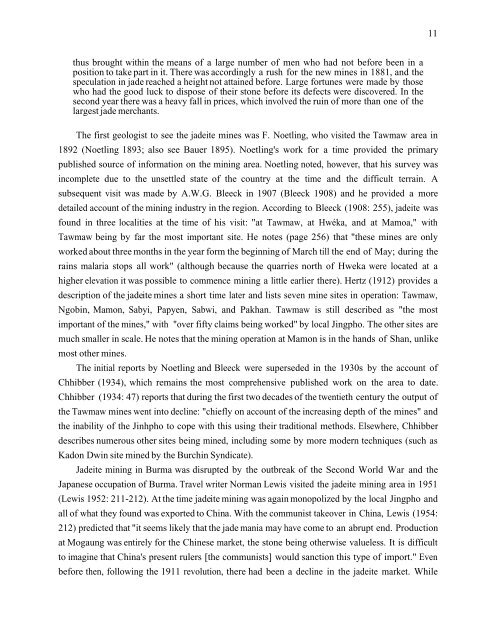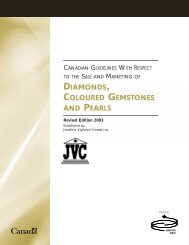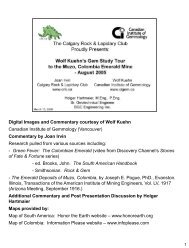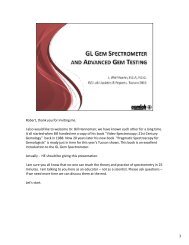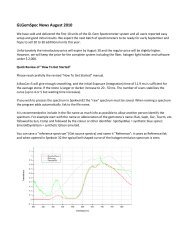JADEITE - Canadian Institute of Gemmology
JADEITE - Canadian Institute of Gemmology
JADEITE - Canadian Institute of Gemmology
Create successful ePaper yourself
Turn your PDF publications into a flip-book with our unique Google optimized e-Paper software.
thus brought within the means <strong>of</strong> a large number <strong>of</strong> men who had not before been in a<br />
position to take part in it. There was accordingly a rush for the new mines in 1881, and the<br />
speculation in jade reached a height not attained before. Large fortunes were made by those<br />
who had the good luck to dispose <strong>of</strong> their stone before its defects were discovered. In the<br />
second year there was a heavy fall in prices, which involved the ruin <strong>of</strong> more than one <strong>of</strong> the<br />
largest jade merchants.<br />
The first geologist to see the jadeite mines was F. Noetling, who visited the Tawmaw area in<br />
1892 (Noetling 1893; also see Bauer 1895). Noetling's work for a time provided the primary<br />
published source <strong>of</strong> information on the mining area. Noetling noted, however, that his survey was<br />
incomplete due to the unsettled state <strong>of</strong> the country at the time and the difficult terrain. A<br />
subsequent visit was made by A.W.G. Bleeck in 1907 (Bleeck 1908) and he provided a more<br />
detailed account <strong>of</strong> the mining industry in the region. According to Bleeck (1908: 255), jadeite was<br />
found in three localities at the time <strong>of</strong> his visit: "at Tawmaw, at Hwéka, and at Mamoa," with<br />
Tawmaw being by far the most important site. He notes (page 256) that "these mines are only<br />
worked about three months in the year form the beginning <strong>of</strong> March till the end <strong>of</strong> May; during the<br />
rains malaria stops all work" (although because the quarries north <strong>of</strong> Hweka were located at a<br />
higher elevation it was possible to commence mining a little earlier there). Hertz (1912) provides a<br />
description <strong>of</strong> the jadeite mines a short time later and lists seven mine sites in operation: Tawmaw,<br />
Ngobin, Mamon, Sabyi, Papyen, Sabwi, and Pakhan. Tawmaw is still described as "the most<br />
important <strong>of</strong> the mines," with "over fifty claims being worked" by local Jingpho. The other sites are<br />
much smaller in scale. He notes that the mining operation at Mamon is in the hands <strong>of</strong> Shan, unlike<br />
most other mines.<br />
The initial reports by Noetling and Bleeck were superseded in the 1930s by the account <strong>of</strong><br />
Chhibber (1934), which remains the most comprehensive published work on the area to date.<br />
Chhibber (1934: 47) reports that during the first two decades <strong>of</strong> the twentieth century the output <strong>of</strong><br />
the Tawmaw mines went into decline: "chiefly on account <strong>of</strong> the increasing depth <strong>of</strong> the mines" and<br />
the inability <strong>of</strong> the Jinhpho to cope with this using their traditional methods. Elsewhere, Chhibber<br />
describes numerous other sites being mined, including some by more modern techniques (such as<br />
Kadon Dwin site mined by the Burchin Syndicate).<br />
Jadeite mining in Burma was disrupted by the outbreak <strong>of</strong> the Second World War and the<br />
Japanese occupation <strong>of</strong> Burma. Travel writer Norman Lewis visited the jadeite mining area in 1951<br />
(Lewis 1952: 211-212). At the time jadeite mining was again monopolized by the local Jingpho and<br />
all <strong>of</strong> what they found was exported to China. With the communist takeover in China, Lewis (1954:<br />
212) predicted that "it seems likely that the jade mania may have come to an abrupt end. Production<br />
at Mogaung was entirely for the Chinese market, the stone being otherwise valueless. It is difficult<br />
to imagine that China's present rulers [the communists] would sanction this type <strong>of</strong> import." Even<br />
before then, following the 1911 revolution, there had been a decline in the jadeite market. While<br />
11


